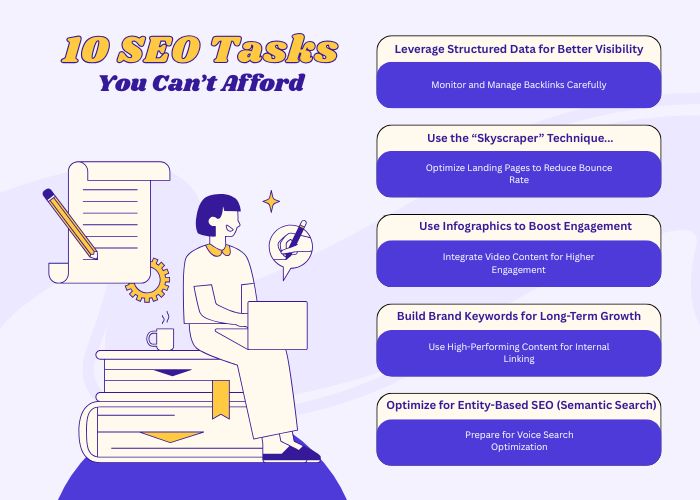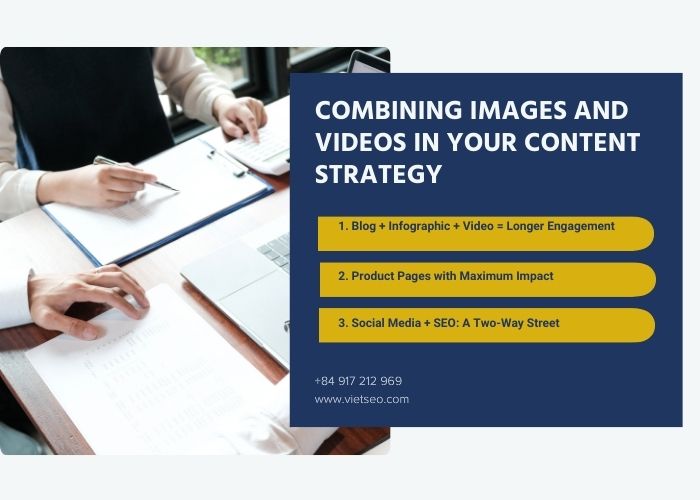10 SEO Tasks You Can’t Afford to Miss for Higher Rankings
The SEO landscape evolves quickly. What worked last year may no longer be enough, and if you’re not actively optimizing, competitors will soon leave you behind. To help your website build sustainable growth and stay competitive, Viet SEO has compiled 10 powerful yet often overlooked SEO strategies that can make a big difference.
1. Leverage Structured Data for Better Visibility
Structured data (also known as schema markup) is like giving Google a “cheat sheet” about your content. By adding extra context to your pages, you help search engines understand what your content is really about — which can unlock rich results in search. These are the eye-catching snippets you see on Google that often feature star ratings, event details, FAQs, or product information.
Common types of structured data you can use:
- Articles – Highlight news pieces, guides, or blog posts.
- Events – Showcase event dates, times, and locations directly in search results.
- Products – Display prices, availability, and reviews for e-commerce pages.
- Local Businesses – Improve visibility for your store or service in Google Maps.
- Recipes – Add cooking times, calories, and ingredients for food blogs.
- Reviews – Feature star ratings and customer feedback to increase trust.
How to implement structured data effectively:
- Use Schema.org to find the right markup for your content type.
- Add the markup code directly to your site (or via plugins if you use WordPress).
- Validate your implementation using Google’s Rich Results Test tool.
- Monitor performance in Google Search Console to see if your structured data is being detected and generating impressions.
The key benefits:
- Higher CTR (Click-Through Rate): Eye-catching snippets attract more clicks than plain listings.
- Improved search appearance: Your results stand out on both desktop and mobile.
- Enhanced mobile experience: Rich results are easier to engage with on small screens, giving you an edge in mobile-first indexing.
In short, structured data makes your content easier for Google to interpret and more appealing for users to click — a simple but often underused tactic that can significantly boost traffic.
2. Monitor and Manage Backlinks Carefully
Backlinks remain one of the strongest ranking signals in SEO. A handful of high-quality links from reputable websites can significantly boost your authority, while a flood of spammy or irrelevant links can drag your rankings down — or even trigger a Google penalty. That’s why active backlink management is essential.
Best practices for healthy backlink management:
- Audit regularly: Use tools like Ahrefs, SEMrush, or Moz to analyze your backlink profile and identify suspicious links.
- Disavow toxic links: If you find harmful backlinks (from spammy directories, link farms, or irrelevant sites), use Google Search Console’s Disavow Tool to neutralize them.
- Manual check in Google Search Console:
- Log into GSC and select your property.
- Navigate to Links → Legacy Tools and Reports to review referring domains.
- Look for unusual spikes or irrelevant domains.
Key benefits: Keeping your backlink profile clean protects your site from penalties, ensures your authority grows naturally, and builds long-term SEO stability.
3. Use the “Skyscraper” Technique for Content Creation
The Skyscraper Technique, popularized by Brian Dean, is a content strategy designed to help you stand out in competitive niches. The idea is simple: find what’s already performing well, then create something even better — more comprehensive, more up-to-date, and more valuable to readers.
How to execute effectively:
- Identify top-performing content – Use tools like BuzzSumo, SEMrush, or Ahrefs Content Explorer to see which articles in your niche are generating the most shares and backlinks.
- Create superior content – Expand on those articles with fresher data, deeper insights, better visuals, and a clearer structure. Make your piece the definitive resource on the topic.
- Promote strategically – Reach out to bloggers, influencers, or sites that linked to or shared the original content. Show them your improved version and encourage them to reference it.
Key benefits: The Skyscraper Technique naturally attracts backlinks, increases brand authority, and drives consistent traffic — without resorting to spammy link-building tactics.
4. Optimize Landing Pages to Reduce Bounce Rate
Bounce rate is one of the most telling signals about how users experience your website. If visitors land on a page and leave almost immediately, it tells Google that the content didn’t meet their expectations — and this can negatively affect your rankings. Optimizing your landing pages to reduce bounce rate is therefore a crucial step in strengthening both user experience and SEO performance.
Practical optimization tips:
- Align titles and meta descriptions with content: Make sure what you promise in search results matches exactly what users find on the page. Misleading titles may bring clicks, but they also drive people away.
- Enhance UX/UI design and page speed: A slow-loading or cluttered page frustrates users. Optimize for speed, use clean layouts, and ensure mobile responsiveness.
- Include clear calls-to-action (CTAs): Guide visitors toward the next step — whether it’s reading another article, signing up for a newsletter, or exploring a product page. A strong CTA keeps users engaged and lowers exit rates.
Key benefits: By improving the relevance and usability of your landing pages, you’ll not only reduce bounce rates but also:
- Increase dwell time (how long users stay on your site)
- Boost conversion rates
- Send stronger positive signals to Google, which can improve rankings over time
5. Use Infographics to Boost Engagement
Humans process visuals faster than text, which makes infographics a powerful way to simplify complex information and make it more engaging. They not only help your audience understand key ideas at a glance but also encourage sharing — creating opportunities for organic reach and backlinks.
How to create and use infographics effectively:
- Design tools: Use platforms like Canva, Figma, or Photoshop, or collaborate with a professional designer to ensure your graphics look polished.
- Distribute widely: Post your infographics on your website, share them on social media, and publish them on visual platforms like Pinterest and Infogram.
- Encourage backlinks: When other sites or blogs use your infographic, ask them to credit your website with a link. Over time, this can generate high-quality backlinks.
Key benefits: Infographics drive traffic, increase shares across platforms, and naturally attract backlinks — all of which boost your site’s authority and visibility.
6. Integrate Video Content for Higher Engagement
Video has become one of the most consumed content formats online — and for good reason. Videos keep visitors on your site longer, improve the overall user experience, and send positive signals to search engines. Whether you’re running a blog, e-commerce store, or service site, adding video can take your content strategy to the next level.
How to use videos effectively:
- Content ideas: Create short tutorials, product demonstrations, explainer videos, or industry insights.
- Optimize for SEO: Add keyword-rich titles, descriptions, and tags to your videos, and host them on platforms like YouTube or Vimeo for additional reach.
- Embed into articles: Incorporate relevant videos directly into your blog posts or landing pages to make them more engaging and interactive.
Key benefits: Video content increases dwell time, encourages interaction, and improves search rankings — while also making your brand more relatable and memorable.
7. Build Brand Keywords for Long-Term Growth
While generic keywords (like “SEO services” or “digital marketing”) are important, they’re often highly competitive. To secure long-term growth, you should also invest in branded keywords — search terms that include your company or product name. These keywords not only improve visibility but also help establish authority and recognition in your niche.
How to build and strengthen brand keywords:
- Incorporate your brand name into target phrases (e.g., “Viet SEO digital marketing services” or “VietSEO SEO training”).
- Optimize content around branded terms — create blog posts, case studies, and landing pages that highlight your brand.
- Leverage local language for regional targeting — for example, use Vietnamese branded keywords when targeting local customers in Ho Chi Minh City or Binh Duong.
Key benefits: By building a strong branded keyword portfolio, you’ll improve brand recall, dominate search results for your own name, and capture traffic from users who already trust or are curious about your business.
8. Use High-Performing Content for Internal Linking
Your website likely has a handful of pages that outperform the rest in terms of traffic, backlinks, or user engagement. These high-performing pages hold significant SEO authority — and you can leverage them to lift weaker pages through internal linking.
Execution strategy:
- Identify top-performing content using tools like Google Search Console or Ahrefs. Look for blog posts or pages with high impressions, clicks, or backlinks.
- Link strategically: From those authority pages, link to lower-ranking or newer pages that need a boost. Make sure the anchor text is relevant and keyword-rich.
- Refresh older content: Update these high-performing articles regularly to keep them relevant while maintaining strong link equity.
Key benefits: Smart internal linking improves crawlability, helps distribute SEO authority across your site, boosts indexing speed, and strengthens the overall visibility of your website.
9. Optimize for Entity-Based SEO (Semantic Search)
Google’s algorithms are no longer just matching keywords — they’re focusing on entities and context to understand the meaning behind search queries. This is known as semantic search, and optimizing for it can give your website a powerful edge in visibility.
How to optimize for semantic SEO:
- Apply Schema Markup: Use structured data to clearly define people, places, products, or organizations in your content. This helps Google connect your page with recognized entities in its Knowledge Graph.
- Write comprehensive, topic-focused articles: Instead of chasing keywords, cover a subject in depth. Anticipate related questions and provide detailed answers.
- Use natural, conversational language: Write the way people speak and search. This makes your content more context-friendly and better suited for Google’s semantic analysis.
Key benefits: Optimizing for entities improves your chances of appearing in knowledge panels, featured snippets, and semantic search results — all of which increase credibility and clicks.
10. Prepare for Voice Search Optimization
With virtual assistants like Google Assistant, Siri, and Alexa becoming more common, voice search is transforming how people find information. Voice queries are typically longer, more conversational, and demand direct, concise answers. Ignoring this trend could mean missing out on a growing traffic channel.
Tips for effective voice SEO:
- Create FAQ-style content: Answer specific questions in short, clear sentences that voice assistants can easily read aloud.
- Target long-tail keywords: Focus on natural-sounding phrases that reflect how people actually speak, not just how they type.
- Optimize for speed: Voice search favors fast-loading websites, so ensure your site performance is optimized for both mobile and desktop.
Key benefits: By preparing for voice search, you increase your chances of being selected as the spoken result by virtual assistants — giving your brand a direct line to users who prefer hands-free searching.
Conclusion
SEO isn’t something you set up once and forget - it’s an ongoing process of refinement and growth. The ten strategies we’ve covered here may be overlooked by many businesses, but when applied consistently, they can make a big difference in your long-term success.
By combining these tactics - from structured data and backlink management to voice search and entity optimization - you’ll create a stronger foundation for your website. With VietSEO’s 19+ years of experience, our team can help you turn these strategies into a practical roadmap that improves rankings, builds authority, and attracts the right customers month after month.
Your turn: Which of these strategies have you already tried? Which ones do you want to explore next? Share your experience - we’d love to hear your thoughts!



